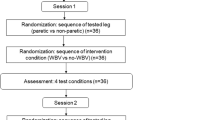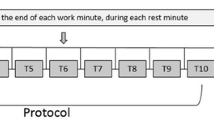Abstract
Purpose
Impaired leg arterial stiffness (pulse wave velocity, PWV) and vasodilatory function are found after stroke. Acute passive vibration (PV) decreases leg PWV (legPWV) and pressure wave reflection (aortic augmentation index, aAIx) in healthy men. Our objective was to evaluate the effects of acute PV on aAIx and PWV in the paretic and non-paretic sides in stroke survivors.
Methods
Eleven stroke survivors (4 females) were randomized to either no-PV (control) or PV (25 Hz and 2 mm amplitude) trials on two separated visits. Following 20 min of supine rest with legs on a vibration platform, blood pressure, PWV, and aAIx were gathered before 10 continuous minutes of control or PV. Measurements were repeated at post-5, post-15, and post-30 min after control or PV.
Results
LegPWV and brachial-ankle PWV (baPWV, systemic stiffness) in paretic and non-paretic sides along with aAIx were significantly (P < 0.05) decreased from baseline at post-5 min after PV compared with control. At post-15 min, paretic and non-paretic legPWV remained significantly lower than baseline, but only non-paretic legPWV was different from control. We noted correlations between changes in paretic legPWV and changes in paretic baPWV (r = 0.47, P = 0.028) and aAIx (r = 0.51, P = 0.017) at post-5 min.
Conclusions
Acute PV applied to the legs of stroke survivors reduces systemic arterial stiffness and aortic wave reflection due to a reduction in leg arterial stiffness, which last longer in the non-paretic than in the paretic leg.


Similar content being viewed by others
Abbreviations
- PWV:
-
Pulse wave velocity
- baPWV:
-
Brachial-ankle pulse wave velocity
- aorticPWV:
-
Aortic pulse wave velocity
- legPWV:
-
Leg pulse wave velocity
- aAIx:
-
Aortic augmentation index
- AIx:
-
Augmentation index
- WBVE:
-
Whole-body vibration exercise
- PV:
-
Passive vibration
- BP:
-
Blood pressure
- DBP:
-
Diastolic blood pressure
- Control:
-
No passive vibration
- HR:
-
Heart rate
- ECG:
-
Electrocardiogram
- SBP:
-
Systolic blood pressure
- PP:
-
Pulse pressure
- P1:
-
Aortic pressure wave composed of a forward wave
- P2:
-
Aortic pressure wave composed of a reflected wave
- aAIx@75:
-
AIx normalized to a heart rate of 75 bpm
- Tr:
-
Time of reflection
- BMI:
-
Body mass index
References
Adkisson EJ, Casey DP, Beck DT, Gurovich AN, Martin JS, Braith RW (2010) Central, peripheral and resistance arterial reactivity: fluctuates during the phases of the menstrual cycle. Exp Biol Med (Maywood) 235:111–118
Ding FH, Li Y, Li LH, Wang JG (2012) Impact of heart rate on central hemodynamics and stroke: a meta-analysis of beta-blocker trials. Am J Hypertens 26:118–125
Figueroa A, Vicil F (2011) Post-exercise aortic hemodynamic responses to low-intensity resistance exercise with and without vascular occlusion. Scand J Med Sci Sports 21:431–436
Figueroa A, Vicil F, Sanchez-Gonzalez MA (2011) Acute exercise with whole-body vibration decreases wave reflection and leg arterial stiffness. Am J Cardiovasc Dis 1:60–67
Gordon NF, Gulanick M, Costa F, Fletcher G, Franklin BA, Roth EJ et al (2004) Physical activity and exercise recommendations for stroke survivors: an American Heart Association scientific statement from the Council on Clinical Cardiology, Subcommittee on Exercise, Cardiac Rehabilitation, and Prevention; the Council on Cardiovascular Nursing; the Council on Nutrition, Physical Activity, and Metabolism; and the Stroke Council. Circulation 109:2031–2041
Han JY, Choi DH, Choi SW, Kim BB, Ki YJ, Chung JW et al (2012) Predictive value of brachial-ankle pulse wave velocity for cardiovascular events. Am J Med Sci. doi:10.1097/MAJ.0b013e318268c05a (publish ahead of print)
Heffernan KS, Rossow L, Jae SY, Shokunbi HG, Gibson EM, Fernhall B (2006) Effect of single-leg resistance exercise on regional arterial stiffness. Eur J Appl Physiol 98:185–190
Herrero AJ, Menendez H, Gil L, Martín J, Martín T, García-López D et al (2011) Effects of whole-body vibration on blood flow and neuromuscular activity in spinal cord injury. Spinal Cord 49:554–559
Ivey FM, Gardner AW, Dobrovolny CL, Macko RF (2004) Unilateral impairment of leg blood flow in chronic stroke patients. Cerebrovasc Dis 18:283–289
Ivey FM, Hafer-Macko CE, Ryan AS, Macko RF (2010) Impaired leg vasodilatory function after stroke: adaptations with treadmill exercise training. Stroke 41:2913–2917
Kim DH, Kim J, Kim JM, Lee AY (2008) Increased brachial-ankle pulse wave velocity is independently associated with risk of cerebral ischemic small vessel disease in elderly hypertensive patients. Clin Neurol Neurosurg 110:599–604
Kim J, Cha MJ, Lee DH, Lee HS, Nam CM, Nam HS et al (2011) The association between cerebral atherosclerosis and arterial stiffness in acute ischemic stroke. Atherosclerosis 219:887–891
Kingwell BA, Berry KL, Cameron JD, Jennings GL, Dart AM (1997) Arterial compliance increases after moderate-intensity cycling. Am J Physiol 273:H2186–H2191
Laurent S, Cockcroft J, Van Bortel L, Boutouyrie P, Giannattasio C, Hayoz D et al (2006) Expert consensus document on arterial stiffness: methodological issues and clinical applications. Eur Heart J 27:2588–2605
London GM (1997) Large arteries haemodynamics: conduit versus cushioning function. Blood Press Suppl 2:48–51
Maloney-Hinds C, Petrofsky JS, Zimmerman G (2008) The effect of 30 Hz vs. 50 Hz passive vibration and duration of vibration on skin blood flow in the arm. Med Sci Monit 14:CR112–CR116
Mattace-Raso FU, van der Cammen TJ, Hofman A, van Popele NM, Bos ML, Schalekamp MA et al (2006) Arterial stiffness and risk of coronary heart disease and stroke: the Rotterdam Study. Circulation 113:657–663
McEniery CM, Yasmin Hall IR, Qasem A, Wilkinson IB, Cockcroft JR et al (2005) Normal vascular aging: differential effects on wave reflection and aortic pulse wave velocity: the Anglo-Cardiff Collaborative Trial (ACCT). J Am Coll Cardiol 46:1753–1760
Nichols WW, Singh BM (2002) Augmentation index as a measure of peripheral vascular disease state. Curr Opin Cardiol 17:543–551
Okabe R, Inaba M, Sakai S, Ishimura E, Moriguchi A, Shoji T et al (2004) Increased arterial stiffening and thickening in the paretic lower limb in patients with hemiparesis. Clin Sci (Lond) 106:613–618
O’Rourke MF, Pauca A, Jiang XJ (2001) Pulse wave analysis. Br J Clin Pharmacol 51:507–522
Otsuki T, Takanami Y, Aoi W, Kawai Y, Ichikawa H, Yoshikawa T (2008) Arterial stiffness acutely decreases after whole-body vibration in humans. Acta Physiol (Oxf) 194:189–194
Roelants M, Verschueren SM, Delecluse C, Levin O, Stijnen V (2006) Whole-body-vibration-induced increase in leg muscle activity during different squat exercises. J Strength Cond Res 20:124–129
Sacre JW, Holland DJ, Jenkins C, Sharman JE (2012) Augmentation index immediately after maximal exercise in patients with type 2 diabetes mellitus. Med Sci Sports Exerc 44:75–83
Sanchez-Gonzalez MA, Wong A, Vicil F, Gil R, Park SY, Figueroa A (2012) Impact of passive vibration on pressure pulse wave characteristics. J Hum Hypertens 26:610–615
Schmitt M, Avolio A, Qasem A, McEniery CM, Butlin M, Wilkinson IB et al (2005) Basal NO locally modulates human iliac artery function in vivo. Hypertension 46:227–231
Soiza RL, Davie MM, Williams DJ (2010) Use of the augmentation index to predict short-term outcome after acute ischemic stroke. Am J Hypertens 23:737–742
Sugawara J, Hayashi K, Yokoi T, Cortez-Cooper MY, DeVan AE, Anton MA et al (2005) Brachial-ankle pulse wave velocity: an index of central arterial stiffness? J Hum Hypertens 19:401–406
Suzuki E, Kashiwagi A, Nishio Y, Egawa K, Shimizu S, Maegawa H et al (2001) Increased arterial wall stiffness limits flow volume in the lower extremities in type 2 diabetic patients. Diabetes Care 24:2107–2114
Towfighi A, Saver JL (2011) Stroke declines from third to fourth leading cause of death in the United States: historical perspective and challenges ahead. Stroke 42:2351–2355
Wilkinson IB, MacCallum H, Flint L, Cockcroft JR, Newby DE, Webb DJ (2000) The influence of heart rate on augmentation index and central arterial pressure in humans. J Physiol 525:263–270
Wilkinson IB, Hall IR, MacCallum H, Mackenzie IS, McEniery CM, van der Arend BJ et al (2002) Pulse-wave analysis: clinical evaluation of a noninvasive, widely applicable method for assessing endothelial function. Arterioscler Thromb Vasc Biol 22:147–152
Wong A, Sanchez-Gonzalez MA, Gil R, Vicil F, Park SY, Figueroa A (2012) Passive vibration on the legs reduces peripheral and systemic arterial stiffness. Hypertens Res 35:126–127
Yamashina A, Tomiyama H, Takeda K, Tsuda H, Arai T, Hirose K et al (2002) Validity, reproducibility, and clinical significance of noninvasive brachial-ankle pulse wave velocity measurement. Hypertens Res 25:359–364
Acknowledgments
We thank Dr. Jacob VanLandingham, Sheree Porter, Tallahassee Memorial Hospital’s Stroke Wellness Group, Mrs. Nimmons, Aphasia Communication Group at FSU’s Department of Communication Disorders, Mary Gebel and Stroke Support Group for help with subject recruitment. We also thank Power Plate International for providing the vibrating platforms. We are grateful to our participants.
Conflict of interest
The authors declare no conflict of interest.
Author information
Authors and Affiliations
Corresponding author
Additional information
Communicated by David C. Poole.
Clinicaltrial.gov register, NCT01841840.
Rights and permissions
About this article
Cite this article
Koutnik, A.P., Wong, A., Kalfon, R. et al. Acute passive vibration reduces arterial stiffness and aortic wave reflection in stroke survivors. Eur J Appl Physiol 114, 105–111 (2014). https://doi.org/10.1007/s00421-013-2756-y
Received:
Accepted:
Published:
Issue Date:
DOI: https://doi.org/10.1007/s00421-013-2756-y




